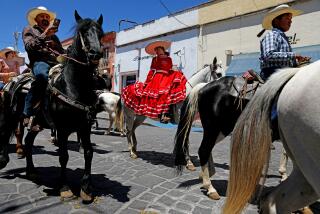Chiapas Villagers, Rebels Seek Reconciliation
IBARRA, Mexico — As government and Zapatista National Liberation Army delegates reported a preliminary agreement Monday in talks aimed at easing tensions in the southernmost state of Chiapas, smaller-scale negotiations were taking place in dozens of jungle villages like this one that have been split by the 17-month rebellion.
Twenty-three families--who have been refugees in the county seat, Ocosingo, since Zapatistas drove them from their homes in September, calling them government spies--sent a two-man committee back to their hometown over the weekend to ask for permission to return.
“We are waiting for their answer,” said Rafael Lopez Santis, one of the village founders who cut Ibarra from the jungle 25 years ago.
“If the Zapatistas will let us, we want to go back,” he said at the converted warehouse where he and 137 other Ibarra residents have lived for eight months.
Now that the government and rebels are talking, in negotiations that recessed Monday and are set to resume June 6, the refugees felt encouraged to try a reconciliation, although they recognize that bitterness on both sides will make a reunion difficult.
Their efforts to find a way back to being neighbors with the Zapatistas are a microcosm of the difficulties that government and rebel delegates face as they try to negotiate peace.
The Zapatistas, who had said they would accept their neighbors only if they joined rebel ranks, now seemed more conciliatory.
“It all depends on the outcome of the talks,” said Hector, a Zapatista leader, in an interview at his cabin--one of the few buildings in the village that is painted and has a wooden rather than dirt floor.
The talks have raised expectations about an end to the conflict that began Jan. 1, 1994, when Zapatistas briefly occupied several county seats near the Guatemalan border, demanding democracy and better living conditions. The fighting lasted 10 days and left at least 145 people dead. But the months of turmoil since then have created thousands of refugees, as a territory about half the size of Delaware has passed back and forth from rebel to government control.
Across the jungle, refugees have gone home since the Mexican army marched into the formerly rebel-held territory in February. But Zapatista supporters have fled to the hills in fear of soldiers.
Non-rebels also have been reluctant to go back to the most remote villages, such as Ibarra, on the edge of the Montes Azules Nature Preserve, where Zapatista troops are believed to be hiding.
The Mexican army controls the entire area from field camps just outside known Zapatista villages. The delegates have agreed, as a test, to give rebels control of public safety in one as-yet-unspecified part of the jungle, on the condition that they guarantee freedom of transit.
If the plan works, it could be extended to seven other regions that would include 11 villages.
The plan to ease tensions and return all refugees to their homes is the first step toward negotiating a lasting peace that would address the political, social and economic issues at the root of the conflict.
Government negotiators have admitted that the rebels are right in their demands for better living conditions and more participation in government.
Ironically, at the refugee center, Ibarra residents receive medical care and the children have a full-time, certified teacher--a circumstance that Lopez Santis and his neighbors had complained was lacking in their village.
Still, said Dr. Julio Garcia, the government doctor who runs the refugee center: “It is difficult for them to be here. This is not their environment.”
More to Read
Sign up for Essential California
The most important California stories and recommendations in your inbox every morning.
You may occasionally receive promotional content from the Los Angeles Times.










